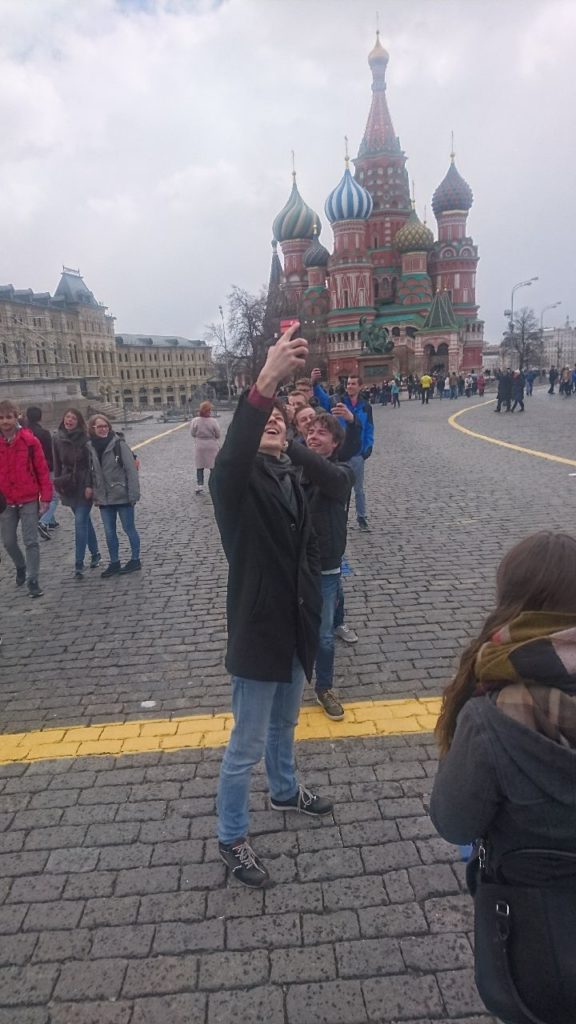Late breakfast seemed to be the consensus today, as we got ready for a long guided tour through the impressive city of Moscow. We were led through the rainy streets by the great Ilena, who told us a lot of interesting things about some of the history, structures and architecture of the nation’s capital.
After the tour, around 5 PM, we went to a coffee bar to hide from the rain and warm ourselves with some hot drinks and some desserts for the hungry people. A metro ride, some brand new Russian SIM cards and an actual dinner later, we arrived at the hotel around 8 PM.
Metro Stations
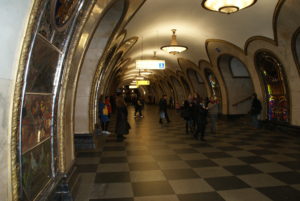
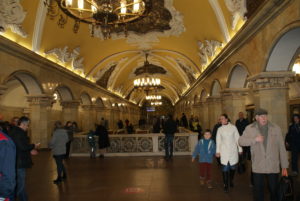
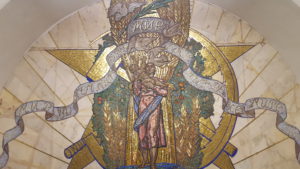
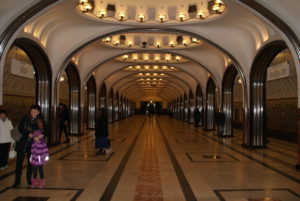
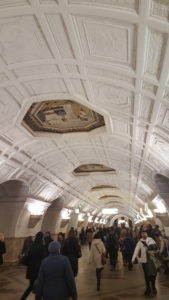
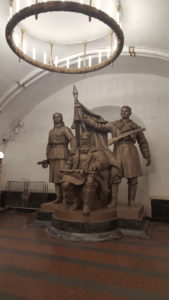
The metro stations in Moscow double as bomb shelters, and are therefore actually military areas. Taking photo’s is prohibited in some places, but we managed to get some anyway. We visited the most beautiful stations in the city, decorated with intricate mosaics and gilded ornaments. These stations were built in the time of Stalin, symbolizing “palaces for the people”. They contain porcelain with gold accents, marble from siberia and onyx and rhodonite from the Ural mountains. There are even entire statues in these tunnels, from a simple bust of Lenin to three huge Belarusian partisans.
Red Square
On our way to the Red Square – where all tourists will sooner or later find themselves – we were taken past some very impressive buildings. On the Plaza Teatralnaya we had a view of the big late 19th century, art-nouveau styled Metropolitan Hotel, and the even more impressive Bolshoj theatre that houses operas and Russia’s world-famous ballet dancers.
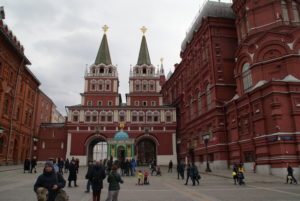
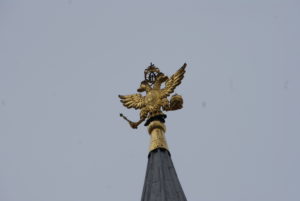
Right before entering the Red Square, on Manezhnaya Square, we encounter the double headed eagle, the main element of the Russian coat of arms. Its one head looks to the east, its other to the west, neatly symbolizing the influences of both Europe and Asia on Russian culture. We also see the big Four Seasons Hotel, of which the left and right side don’t match. It is said that when the architects proposed two versions of the design to Stalin, he signed them both. The designers were too afraid to ask why, so they just built each side of the building in a different style.
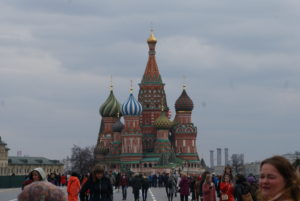
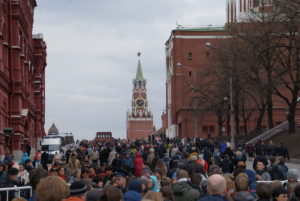
The Red Square isn’t actually red. Surprising, right? The Russian word for “red” could also mean “beautiful”, so a better translation would have been “beautiful square”. It used to be called the “great market”, but after St. Basil’s Cathedral got built, they changed it. And with good reason, even though in real life, the colorful cathedral is a bit small. Legend says that Ivan the Terrible asked the architects if they would ever be able to surpass its beauty. When they told him they could, he blinded them. This is probably not true though, since other buildings were designed by the same people after that. It almost got destroyed by Stalin, who wanted more room for his tanks in their military parades, but luckily he was thwarted by some big architect. The latter had some shady accident afterwards, of course.
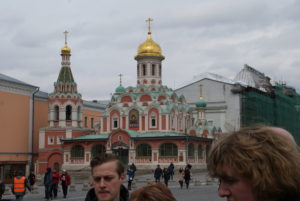
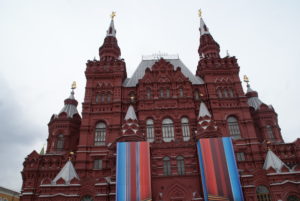
Apart from St. Basil’s, the Red Square is home to some other very notable structures. In the corner, we find a tiny orthodox church (Kazan Cathedral), the first one that was built after the revolution of 1917. Its construction was only completed in 1998.
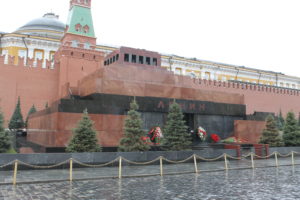
There is also a nice view of Lenin’s Mausoleum, with behind it the very obvious Kremlin Wall. The one that surrounds the current government is the third version. In the very beginning, before the princes of Moscow turned it into the capital of all Russia, it was made of wood. Then it got replaced by a white stone wall, only to be rebuilt into what we see now with the help of Italian architects brought there by the new Italian wife of the tsar. It has 20 unique towers, each with a different name, but still very harmonious. Fun fact: president Putin usually doesn’t work in Moscow, and that’s a good thing, since the roads get closed when he does, resulting in total gridlock.
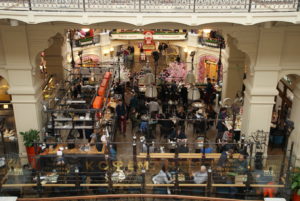
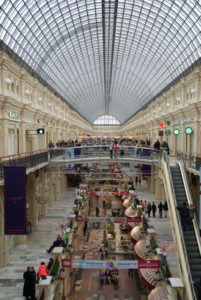
The immense Gum department store fills almost the entire opposite side of the square. It houses some of the most expensive stores in Russia, but also has some surprisingly affordable and quality places to lunch. In Soviet times, entire villages would flock to this store, since it was about the only place where you could actually get something. Imagine queueing up for a pair of shoes for 3 to 4 hours…
Strolling further
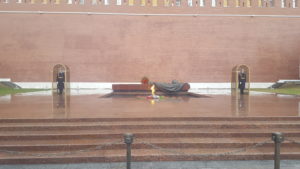
Passing the Grave of the Unknown Soldier – built to commemorate the many who died and never got an official grave – we get to the Alexander Garten. In the times of tsar Alexander I, right after the war against Napoleon, big parts of the city had to be rebuilt. They laid out new gardens, channeling the Neglinnaya River (tributary of the Moskva River) underground. There is still a patch of water to remind citizens of the river that used to flow there. Down the road, a bridge that used to cross this river leads up to one of the two entrances of the Kremlin. The gate is located in the largest of the 20 towers.
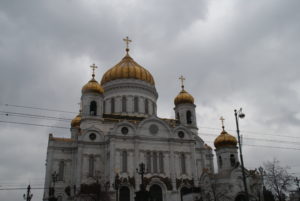
Up next is the big Cathedral of Christ the Saviour. It was demolished in soviet times to make room for the huge 400 meter high Palace of Soviets, which was never built: the seepage from the river made such a large structure impossible. The pit that was dug for the foundation was turned into a swimming pool, and eventually the cathedral was rebuilt and finished in the year 2000.
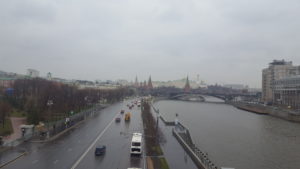
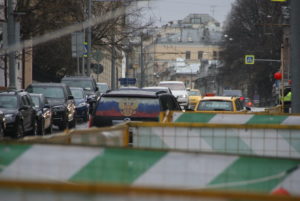
Our last stop, the bridge behind the cathedral, gives a stunning view of the river. There is an odd structure of Peter the Great, who “Europeanized” Russia and stimulated economic and technological growth back in his time. Funnily enough, the statue was probably designed as a tribute to Columbus for some American city, but turned down. Some Muscovites think the architect just changed the head and sold it as the statue we now see here in Russia’s greatest city.
